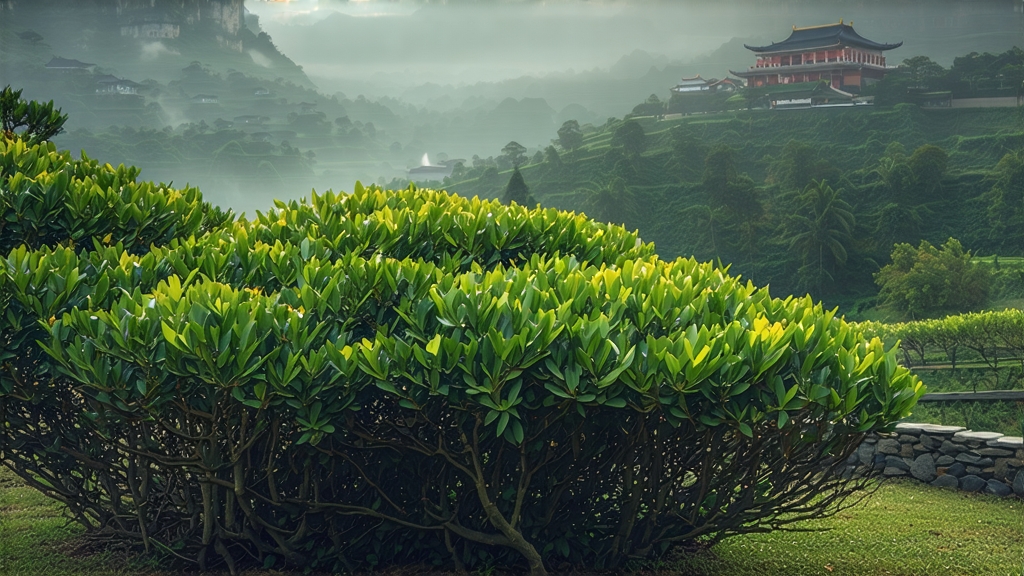
Tie Guan Yin, literally “Iron Goddess of Mercy,” is the most celebrated sub-variety of Chinese oolong. Born in the granite-studded hills of Anxi, southern Fujian, it is both a cultivar and a craft, a leaf that carries five centuries of legend in every curl. Locals still recount how a humble farmer named Wei Yin was guided by Guanyin, the Bodhisattva of Compassion, to a hidden iron statue beneath a neglected tea shrub. After restoring the shrine, the plant beside it flourished, yielding leaves of incomparable fragrance. Wei propagated the bush, named it after the iron icon, and the cultivar Camellia sinensis var. tieguanyin began its journey from temple yard to global cup.
Anxi’s microclimate—morning fog drifting through 1,000-metre valleys, laterite soil laced with mineral-rich mica—creates the ideal stage for slow growth. Leaves remain tender for weeks, accumulating amino acids and floral volatiles that later translate into the famous “Yin Yun,” a cooling, orchid-like sweetness that lingers at the back of the throat long after the liquor is gone.
Three style families now coexist under the Tie Guan Yin banner. Traditional or “Nong Xiang” Tie Guan Yin is charcoal-roasted in bamboo baskets over a lychee-wood fire for 12–30 hours, acquiring chestnut skin, honeyed depth, and a warming finish. Modern “Qing Xiang” or “Light Aroma” skips roasting, showcasing electric-green leaves and a bright, gardenia bouquet. Between them lies the nuanced “Zhong Xiang,” medium oxidised and lightly baked, marrying cream with mineral. Each style is further shaped by the harvest season: spring tea offers crisp clarity, autumn tea delivers riper fruit tones, while the rare winter picking surprises with alpine herbs.
Crafting Tie Guan Yin is a 24-hour choreography of stress and rest. Picking begins at dawn when two leaves and a bud still hold dew; any later and the sun’s heat will lock undesirable greenness. The leaves are sun-withered for 30–40 minutes, then “shaken” in rattan drums every hour through the night. This tossing bruises the edges, allowing enzymes to meet oxygen in a controlled “partial oxidation” that hovers between 25 % and 40 %. When the leaf emits a ringing metallic clang—experienced artisans claim they can hear it—the oxidation is arrested with a 280 °C tumble in massive woks. Hand-rubbing follows, curling the leaf into the distinctive dragonfly-head, frog-leg shape. Finally, the tea is dried, sorted, and either sent for roasting or packed immediately to preserve its jade hue.
Water is the silent ingredient. In Anxi, spring water filtered through granite is preferred for its low TDS (total dissolved solids) and subtle sweetness. Internationally, use bottled water with less than 50 ppm minerals; hard water will flatten aroma and darken liquor. Pre-heat a 120 ml gaiwan or tiny Yixing zisha teapot dedicated to light oolongs. For Qing Xiang style, dose 6 g of leaf—roughly one heaped tablespoon—then flash-rinse with 95 °C water for three seconds to awaken the tightly rolled pearls. The first formal infusion lasts 15 seconds, increasing by five seconds each steep. A quality Tie Guan Yin yields 7–9 brews, the fourth often considered the “soul” infusion where floral top notes subside and a creamy, mineral body emerges. Charcoal-roasted versions tolerate near-boiling water and can be pushed for 12 steeps, revealing cocoa, nutmeg, and a cooling camphor finish.
Professional cupping follows a quieter rhythm. Three grams of leaf are placed in a 150 ml white porcelain tasting set, infused for five minutes with 100 °C water. The lid is lifted first: aroma should rise like steamed milk laced with orchid. Slurp the liquor loudly, aspirating across the palate; sweetness should appear within three seconds at the sides of the tongue, followed by a menthol freshness at the back. Swallow, then exhale through the nose; a lingering, airy bouquet is the hallmark of superior Yin Yun. Finally, inspect the spent leaves: intact, elastic blades with a central crease and reddish fringe indicate perfect oxidation and skilled hand-rubbing.
Storage is critical. Qing